Trawling an album recently, I was traumatized to recall one particular solar installation. I took nearly 20 photos at the time to prove why, in this case, it was such a nightmare.
A nightmare that could have been avoided with a proper pre-installation sales call.
Solar salespeople can get a bad rap. But given some training, the correct process, and the time for a site visit, a tame solar salesperson can be worth their weight in commission. They’ll make or break the entire job with seemingly insignificant details or omissions. This series will explain why.
A Job Of Challenges, Most Of Them Avoidable.
In this case, the salesman was also the company owner, a bloke with incredible technical expertise but almost no attention to sales details.
Starting with the meter box. This two-phase domestic switchboard had been updated within the last ten years, but it was packed full. We have written a handy guide about upgrades previously; but the finer points of this one will be detailed in an upcoming article.
Street Access Matters
If you’re on a narrow, steep, dead-end road with low trees and no signage, it’s worth informing the electricians. They might need space for a trailer or use a crane truck instead. It’s another good reason for salespeople to visit the site.
The best farmer I worked for didn’t let us drive in, he chained the truck to his tractor and dragged us through the mud to where we were working. The worst one couldn’t draw a mud map to save herself, so we were lost.
In this case we rang the customer for the right address, (rates notices are sometimes different to street addresses) but the driveway was so steep the truck couldn’t climb it, nor was there space on the road to park.
Ready Yourself And The House
In this case, things only worsened when the customer threw the garage door up. The joint was jam-packed, and nobody could access the crawl space for this split-level house. We had to come back after the weekend, so a one-day job became two, and a lot of mileage was wasted.
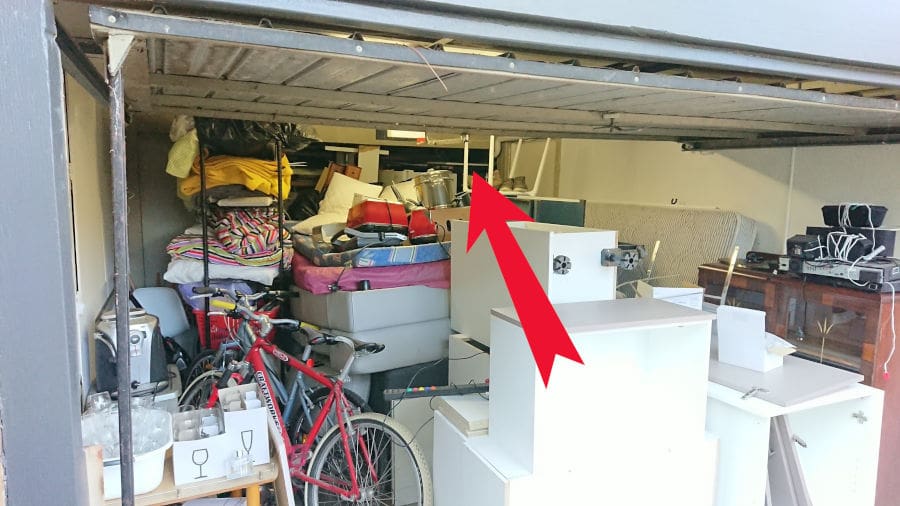
Red arrow indicates I’m not climbing over all that stuff.
It’s worth being ready a week early because the cat herding experts doing solar operations management may ring up with a crew free for tomorrow.
Locating The Equipment
Sales should have it figured out, but remember, smooth installation is as much a customer’s responsibility as it is the trades doing the work.
Try to be reasonable about your aesthetic requirements. There are good reasons or in fact rules for where batteries go in particular. Standard practice to minimise electrical losses puts the inverter right next to the meter box, because cheap and simple aren’t bad things.
In this case we had express instructions; No “ugly” inverter on the approach to the front door. Cue installer eye-roll.
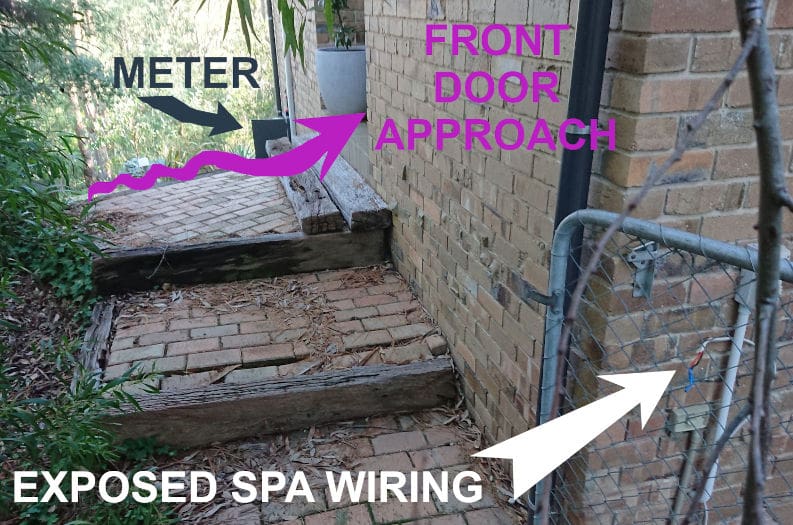
Looking from the back toward the front of the house, the large potplant is right next to the main door.
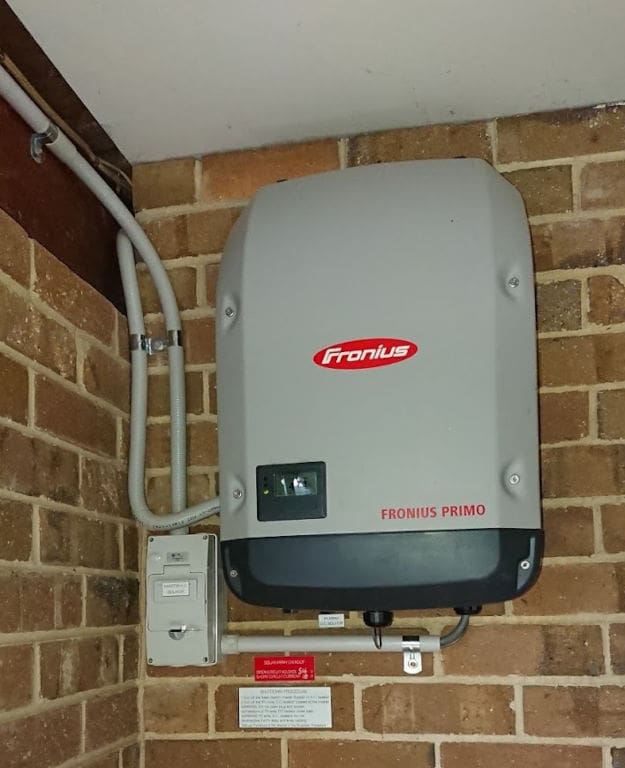
I like putting labels on the wall, they don’t disappear if there’s a warranty unit changed over.
Ironically, the airconditioning installers didn’t get that message. Maybe their white appliance is more attractive, but I think a grey Fronius snap inverter would look quite smart, given the colour scheme of this house.
Incidentally, many solar installers now use plastic ducting designed for air conditioning pipes. It can tidy up wiring and speed installation significantly.
We should have insisted that legally, an inverter needs to be in a high-traffic area so that earth fault alarms are seen. Not everyone notices an email alert, but they’ll often spot a red light which should be green.
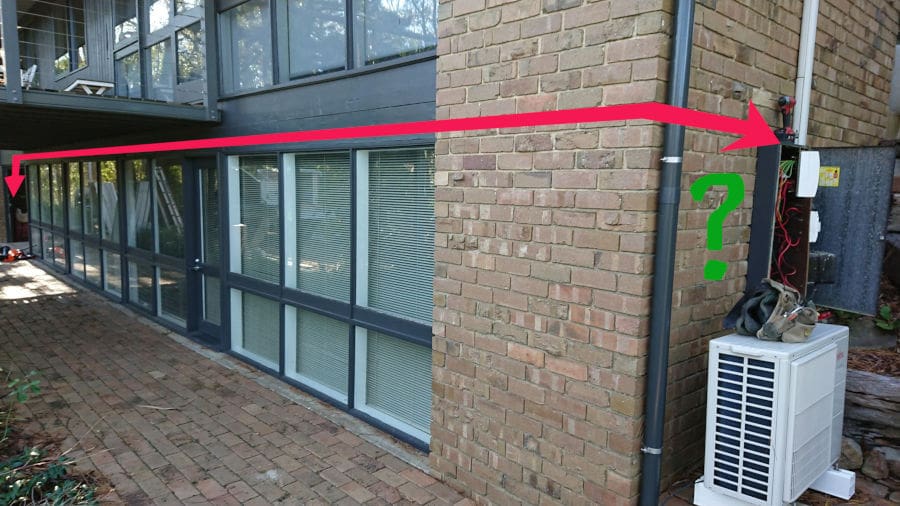
The green question mark is an ideal inverter location. The red arrow indicates an impossible cable path.
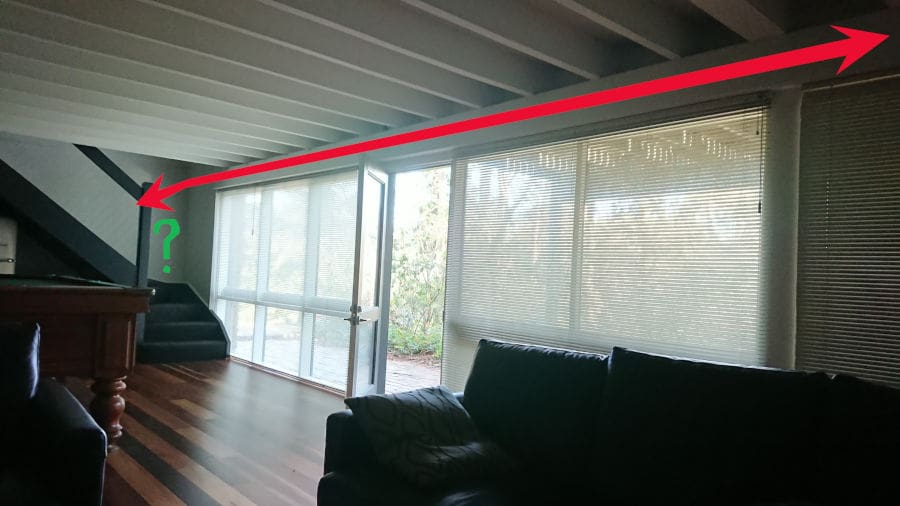
Taken from inside, this building is a pretty thin construction. Running more cables was going to be a pain. The pelmet offered some hope but the staircase wall cavity was too difficult to access
So We Began A Quest
Garages are great places to keep sensitive electronics cool and dry.
In this case, it’s a long way from the WiFi router, but the major challenge was running around the lower living area. It was a wiring run that traversed three sides of the building, using ten times more cable. Follow the photos to see how it’s done.
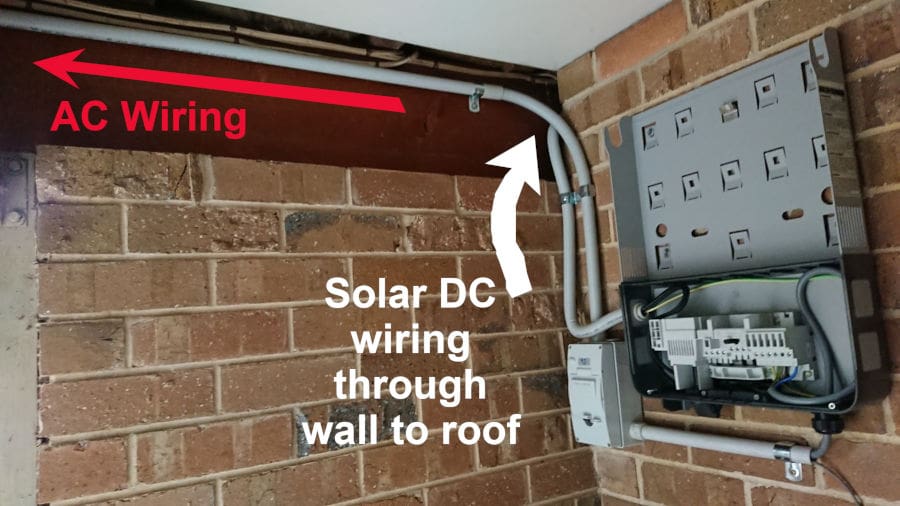
Starting in the northeastern corner of the house, we set off with an AC cable.
These were the days before drain valves for DC conduit, when drilled holes and drip loops were perfectly simple and compliant. Unless it’s a super fancy concealed wiring job, I’d much rather leave the plumbing (and condensation risk) out of the inverter now.
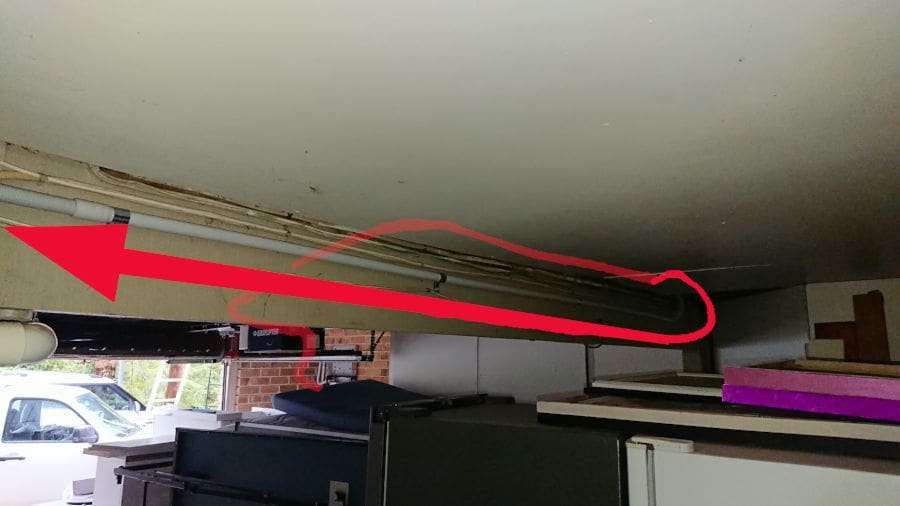
Work your way across the garage, putting conduit saddles where you can reach.
Having to work over, around and above furniture or other prized possessions is always a chore. Nothing will put an installer offside like having to move all your crap just to start the job.
I often insisted cars be moved because I didn’t want to be responsible for damaging them.
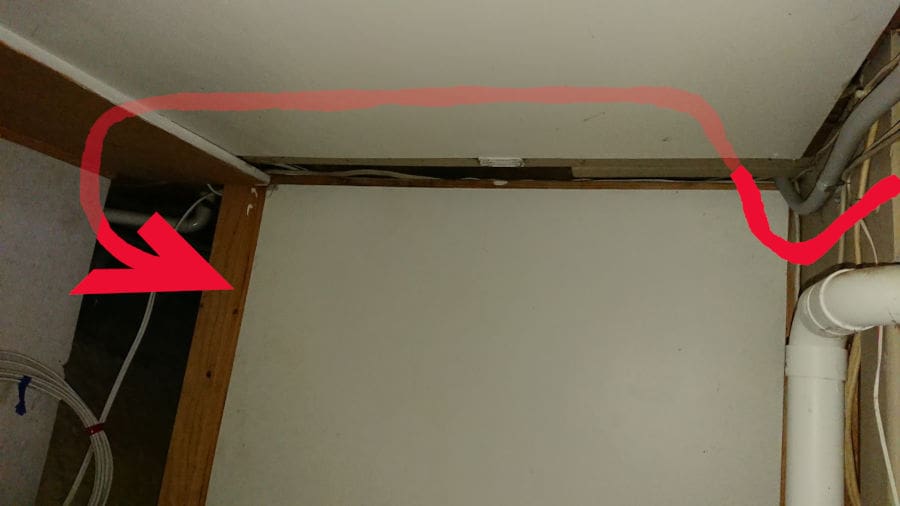
Avoid the plumbing and other services and grab another cable for a separate run to the new spa bath.
Spaces like the one shown below weren’t too bad, but like a ceiling cavity, you never came out clean, and there was always the risk of putting your boot through some plasterboard.
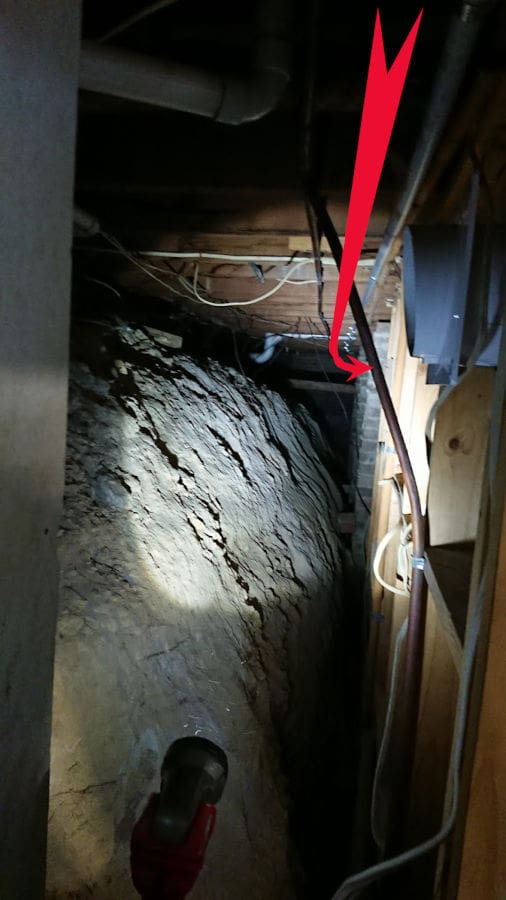
Now run the full length of the back of the house
In this case, we had one stroke of luck: the exposed redundant spa wiring in image two.
Using it as a draw wire, we pulled two new supply cables, from this crawl space, under the front doorstep, through an utterly inaccessible part of the building, and straight into the meter box. Thank dog nothing got jammed.
Clear Communication Is Essential
At the end of the day, solar technology is about people and relationships too. It can be difficult when things go wrong, and they do sometimes. Negotiations between distressed customers, partners, the boss, the salesman, contractors or the electrician can be awkward.
Remember, if it goes pear-shaped, the people who’ve taken your money are also responsible for your warranty under Australian Consumer Law, so you want them to answer the phone.
- Maintaining a good conversation with the installers always makes good sense.
- Be sure the sales representative is across what you think is essential.
- Document your expectations, especially if it’s backup circuits from a battery.
- Deal pragmatically with the operations management and the actual trades on the day.
- If your place is difficult, with a multifaceted roof and long cable runs, then at least ply them with toasted sandwiches and coffee.
- Then go away while they get on with it.
Avoid Legal Conflict
My job here at SolarQuotes sometimes involves negotiating technicalities between warring parties. What I can absolutely guarantee you is that nobody wins in court, except the lawyers.


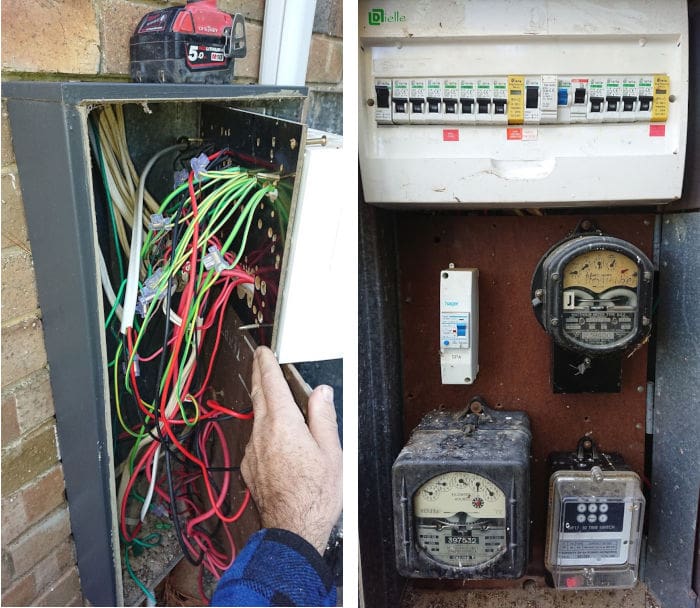
 RSS - Posts
RSS - Posts



I’m in the process of asking for three quotes for a solar installation. One person has sent me a quote following a longish telephone call where he got my ideas all wrong, put solar panel pictures on the wrong side of the house. I guess he didnt feel like coming here in person. Another person has come here, climbed a ladder, taken photos from every angle—that’s the way to go.
In 2009 I was looking to install some rooftop solar. I had 4 potential installers turn up. One got out of his car, looked at the house and said no way (The solar hot water system was on the north face of the roof). The next guy walked to the west side of the house, paced out the width of the roof on the ground, third guy used a tape measure to get the width of the roof. The fourth man got up on the roof, took a “sun chaser” photograph to check potential shading throughout the year. Although he was not the cheapest, number 4 got the job, and did it very well. In 2024 I’ve now got over 6kW of rooftop solar, (on both east and west sides of the roof) and enough batteries etc to support two electric vehicles. Money well spent.
That’s brilliant Joe,
I’m glad there are people out there, on both sides, who really get it.
The salesman, if not an installer needs to know how installers “install” and what their needs are.
If an installer gets to a job and it’s a site nightmare then blame the sales person not the customer. The sales visit is the whole point of the in-person visit and why it is not all organised in the Showroom.
I got 3 quotes. One looked at the house from Google Earth, – he didn’t get the job. Nr 2 came and sat down with me, pushing cheap cells made in China. Nr 3 checked out the house in and outside, and then sent a very detailed quote via email, showing 2 options for cells. German made or Chinese made.
He got the job for the German made ones, more expensive, but Germans make good stuff.